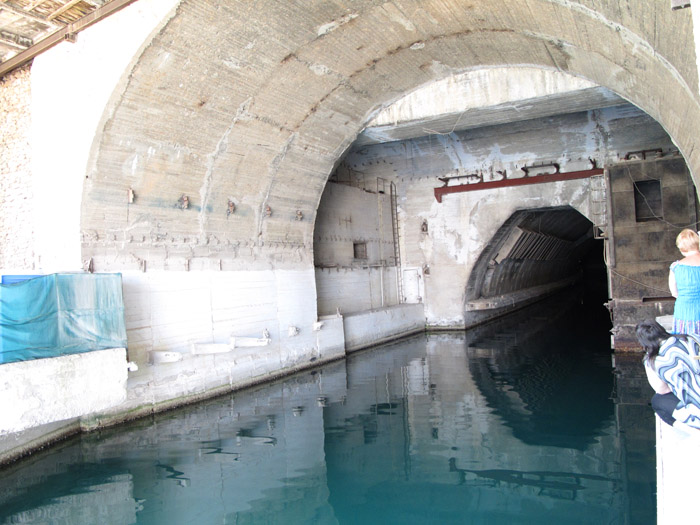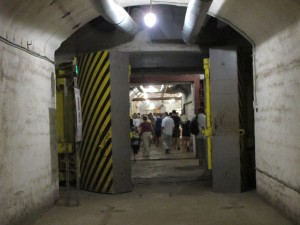 In Balaklava, Ukraine, I visited one of the USSR’s super-secret bases, “Facility 825”. This is a giant semi-submerged underground lair, where submarines could enter, be refueled or repaired, and be entirely invisible from the air.
In Balaklava, Ukraine, I visited one of the USSR’s super-secret bases, “Facility 825”. This is a giant semi-submerged underground lair, where submarines could enter, be refueled or repaired, and be entirely invisible from the air.
Oh yes, and it was designed to survive a 100 kiloton direct hit.
 The base seems to have been conceived in the early 1950s. It was constructed by the teams who had built the Moscow and Kharkiv metro systems, so it isn’t too surprising it takes the form of a giant tunnel, with a concealed entrance in the Balaklava harbor and an exit into the Black sea. The tunnel is wide enough to allow subs to be docked at one side for maintenance, while others slid past in the main channel.
The base seems to have been conceived in the early 1950s. It was constructed by the teams who had built the Moscow and Kharkiv metro systems, so it isn’t too surprising it takes the form of a giant tunnel, with a concealed entrance in the Balaklava harbor and an exit into the Black sea. The tunnel is wide enough to allow subs to be docked at one side for maintenance, while others slid past in the main channel.
 The base is also chock-full other tunnels, for the supporting humans and for the various arsenals.
The base is also chock-full other tunnels, for the supporting humans and for the various arsenals.
Facility 825 was super-secret in its day. The entrance is designed to be invisible from the air. They were initially worried about spy planes, but of course this also worked well against satellites. The Soviets apparently hoped to keep even the existence of the base entirely secret, using various ploys to conceal the construction work.
But where are the nuclear wessels?
It was decommissioned in the early 1990s, but even today it’s hard to find reliable data on what was actually based there. It is generally cited as a “nuclear base”. But as far as I can figure, it was only used for Whiskey and Romeo diesel powered subs (the tunnel was probably too narrow for the later nuclear subs). There were probably nuclear warheads, but even that is a little unclear.
It’s all a wonderful relic from the Cold War. It’s rather sad to see it turned into a rather desultory museum. Where are the international super-villains when you need them? Why aren’t aspiring megalomaniacs bidding frantically to “borrow” it for “historic renovation”? Alas, we live in banal times.

